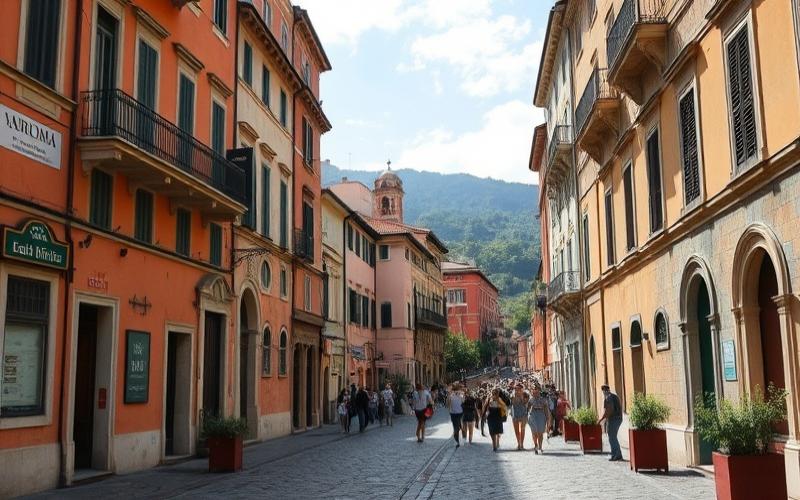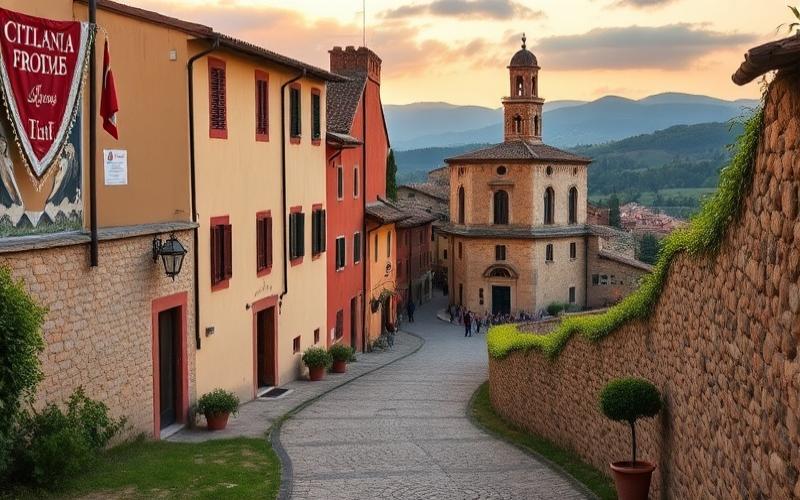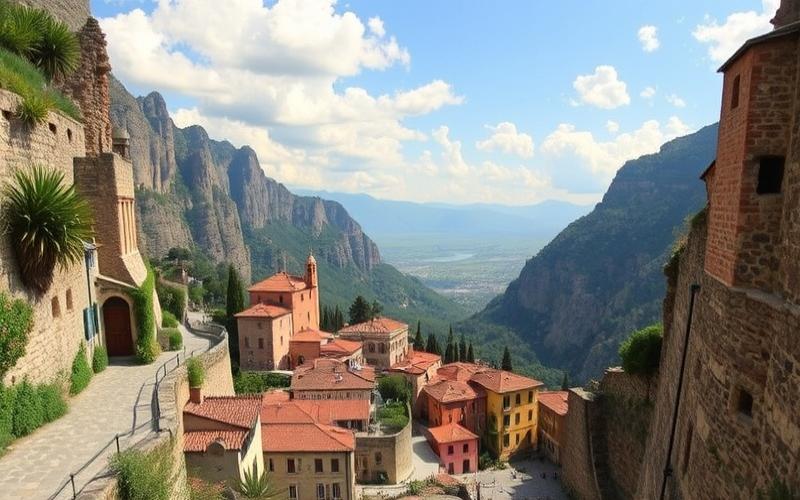
 Published on and written by Cyril Jarnias
Published on and written by Cyril Jarnias
Buying Agricultural Land in Italy
Buying agricultural land in Italy offers compelling opportunities for both investors and agriculture enthusiasts, but it’s essential to navigate the labyrinth of Italian legal regulations carefully.
This guide will provide you with comprehensive information on the necessary procedures, restrictions to consider, and potential tax benefits, allowing you to secure your property while complying with local laws.
Whether you’re interested in cultivating sun-drenched olive trees or expanding your real estate portfolio, understanding the legal subtleties of purchasing land in Italy is a crucial first step toward achieving your projects.
Overview of the Legal Framework for Buying Agricultural Land in Italy
Italy regulates land ownership through the Civil Code, the Constitution, and special laws, with specific rules for agricultural land and real estate transactions, whose sale must be formalized by a notary via the atto di compravendita and mandatory preliminary checks.
Key Legal Standards and Mechanisms
- Civil Code: property transfer via notarized contract and land registry publicity; obligation of good faith and verification of encumbrances, easements, and zoning compliance before the preliminary contract and deed.
- Usucapion (acquisitive prescription): acquisition through continuous possession for 20 years for real estate, according to Article 1158 of the Civil Code.
- Contractual Forms: compromesso (binding promise) committing the parties; atto di compravendita signed before a notary, with registration.
- Land Registry and Cadastral Publicity: registration with the Land Registry/Catasto and issuance of a visura catastale at the end of the procedure.
Role of Authorities
- Notary: checks legality, parties’ identities, encumbrances, zoning compliance, drafts and receives the deed, proceeds with registrations.
- Comune (municipality): issues or validates zoning permits, planning/zoning, and technical certificates (e.g., habitability where applicable), and collects certain local taxes like IMU.
- Land Registry/Cadastral Offices: receipt and processing of the deed for registration in the buyer’s name, issuance of the visura catastale.
Requirements for Foreign Buyers
- Obtaining a codice fiscale to formalize the purchase and registration.
- Standard Documentation: seller’s deed of ownership, cadastral documents, building permit if work is planned, energy performance certificate where applicable.
- Transactions follow the same steps (preliminary contract, notarial deed, registration) with the same compliance, encumbrance, and zoning checks.
Taxes and Fees Related to Buying Agricultural Land
- Imposta Municipale Unica (IMU): annual municipal property tax due to the municipality where the land is located.
- Deed and Registration Fees: handled via the notary who carries out the formalities and filings with the land registry.
- Other Usual Costs: notary fees, technical and cadastral checks, required certificates and zoning documents.
Rights and Restrictions Affecting Agricultural Land
- Zoning and Planning Rules: compliance with local plans, permits, and building regulations; controlled by the Comune.
- Potential Environmental Constraints depending on location (protected areas, easements, real charges), to be identified during preliminary checks.
- Risk of Usucapion by Third Parties in case of uncontested prolonged possession; vigilance on the actual occupation of the land.
Typical Administrative Steps of the Transaction
- Preliminary Checks by the Notary and/or Buyer’s Advisor:
- Seller’s title and capacity; absence of undisclosed mortgages/encumbrances/easements.
- Zoning and planning compliance; existing authorizations or permits; cadastral documentation.
- Tax checks and technical documentation (e.g., energy certificate when required).
- Compromesso: setting price and conditions, payment of a deposit, and setting deadlines.
- Atto di compravendita before Notary: property transfer and collection of applicable taxes/fees.
- Registration:
- Filing of the deed and forms at the local Land Registry/Cadastral office by the notary.
- Issuance of a registration certificate (visura catastale) confirming registration in the buyer’s name.
| Element | Authority/Instrument | Key Point |
|---|---|---|
| Legality Check | Notary | Verifies encumbrances, compliance, identities, drafts deed |
| Zoning/Planning | Comune | Permits, compliance with local plans |
| Land Registry Publicity | Land Registry/Catasto | Registration and visura catastale |
| Property Tax | IMU (municipal) | Due annually according to municipality |
| Acquisitive Prescription | Civil Code art. 1158 | Usucapion after 20 years of possession |
Best Practices to Secure the Purchase of Agricultural Land
- Engage a notary early on for title searches, mortgages, easements, and zoning compliance.
- Obtain and verify the visura catastale and the consistency of cadastral data with the physical reality of the land.
- Ensure the seller’s tax regularity and absence of disputes or bankruptcy affecting the land’s transferability.
- Assess agricultural use restrictions, environmental constraints, and easements before the preliminary contract.
Good to Know:
In Italy, the purchase of agricultural land is governed by the Civil Code and specific laws such as Law 590/1965 which promotes agricultural development; local authorities and the Ministry of Agriculture play a key role in authorizing transactions, particularly regarding land use change restrictions. Foreign buyers must obtain a preliminary authorization “nulla osta” and may be subject to restrictions based on international reciprocity. The purchase includes notary fees, a 9% registration tax, and specific VAT if applicable. Agricultural land may be subject to pre-emption rights in favor of local farmers or neighbors. Environmental regulations sometimes impose constraints on farming methods, and any transaction must be registered in the “Catasto Terreni” to ensure possession validity, often facilitated by a real estate agent or notary expert in rural transactions.
Understanding Rural Zoning in Italy
The main types of rural zoning in Italy include agricultural areas (E), protected areas (parks, Natura 2000 sites, reserves), and rural development areas defined by cohesion policy programs and the National Strategy for Inner Areas (SNAI).
- Agricultural Areas (E): provided for by municipal General Regulatory Plans (PRG) according to DM 1444/1968, with imposed density/height indices and distances between buildings, as well as local rules on uses and buildability.
- Protected Areas: added to PRG classifications via park, reserve, and site regulations, which limit or condition agricultural and construction activities through park plans and protection regulations.
- Rural Development Areas / “Inner Areas”: perimeters identified by SNAI (about 60% of Italian surface area) targeting rural revitalization through integrated projects and funding, without replacing zoning but influencing it via programs and aid conditions.
Legislative and Institutional Framework
- National Planning Basis: municipal planning has been mandatory since the 1942 framework law, organized around PRGs which must classify territory into six categories A–F according to Ministerial Decree 1444 of April 2, 1968, including category E agricultural and urban standards (density, height, distances, provisions).
- Detailed Standards: DM 1444/1968 sets limits/ratios for each zone, which PRGs detail in their regulations and maps, with the possibility of regional rules simplifying planning instruments.
- Rural Development Policies: at national and regional levels, SNAI (since 2012) and Rural Development Programs (RDP) co-funded by the EU structure intervention perimeters and condition uses/funding in rural and mountain territories.
- Regional and Local Specificities: regions and autonomous provinces (e.g., Trentino-Alto Adige/Bolzano) adapt and supplement zoning and land use rules according to their competencies, integrating agro-forestry and mountain constraints into plans.
Effects of Zoning on Agricultural Land Use
- Buildability in Zone E: generally limited to functional agricultural buildings (stables, sheds, greenhouses, annexes) and the farm manager’s service residence, with minimum surface thresholds, very low building indices, and strict distances/heights.
- Change of Use: conversions to residential/tourist uses often prohibited or highly regulated; PRGs impose standards and compliance with indices, with sanctions for violations.
- Protected Areas: in parks/reserves, park plans may prohibit certain clearings, new constructions, intensive irrigation, or pesticide use, or subject them to specific authorization.
- Inner Areas / Rural Development: increased opportunities for aid for diversification (agritourism, on-farm processing, short supply chains) or agro-environmental improvement, subject to territorial eligibility and zoning compliance.
Concrete Examples of Restrictions/Permissions
- Height Limits and Distances Between Buildings: imposed by DM 1444/1968 and adopted by PRGs, applied to new constructions in zone E.
- Low Building Index in Zone E: allowing only volumes related to agricultural activity, with limited built/land ratio and fixed distances to boundaries/plots.
- In a Mountain Province (e.g., Bolzano): topography and predominant allocation to pastures/forests guide predominant agro-forestry use and restrict non-agricultural developments.
- Revitalization Projects in “Inner Areas”: funding conditioned on local plans and zoning compatibility, possibly authorizing collective facilities or services supporting agriculture.
Implications for a Potential Agricultural Land Buyer
- Limited Use: expect construction restrictions (non-agricultural housing often prohibited), obligation to prove agricultural activity, and minimum building areas.
- Overlapping Constraints: an agricultural classification may be doubled with an environmental protection status, strengthening prohibitions and authorization procedures.
- Aid Opportunities: in inner and mountain areas, support exists for modernization, diversification, and services, provided zoning and eligibility criteria are respected.
- Essential Verification: zoning compliance and absence of prior abuses are decisive; Italian history shows sanctions and regularizations in case of abuses.
How to Check a Land’s Zoning Before Purchase
- Request a zoning certificate or urban feasibility study from the municipality to know the zone (A–F), applicable indices, and prescriptions.
- Consult the municipal PRG/PLU (maps and regulations) to locate the plot in zone E or other, and note standards (density, height, distances).
- Check overlapping constraints: park/reserve perimeters, landscape protections, “inner areas,” and rural development program perimeters that may condition aid and uses.
- Examine relevant regional plans and regulations, especially in autonomous regions/provinces where specific mountain and agro-forestry zone rules apply.
- Have the cadastral file and permit history analyzed to detect potential abuses or non-compliance.
Where to Obtain Information
- City Hall/Zoning Office: PRG, zoning certificate, permit archives, local easements.
- Region/Autonomous Province: planning portals, park/reserve perimeters, SNAI and RDP schemes.
- Land Registry/Cadastre: parcel data, owners, easements, and consistency between cadastral and zoning status.
- Park/Reserve Authorities: park regulations, internal zoning maps, and authorization procedures.
Summary Table of Zones and Effects
| Zone Type | Main Legal Basis | Typical Effects on Use/Construction |
|---|---|---|
| Agricultural Zone (E) | DM 1444/1968 + Municipal PRG | Construction limited to agricultural needs, strict indices/heights/distances, restricted conversions. |
| Protected Areas | Park and Landscape Protection Laws/Regulations | Prohibitions or conditional authorizations for constructions, clearings, sensitive agricultural practices. |
| Rural Development Areas / Inner Areas | SNAI, Regional RDPs | Aid/facilitations for compatible projects; no automatic derogation from zoning rules. |
Best Practices Before Acquisition
- Engage a planner/lawyer for full due diligence on zoning, constraints, and buildable potential.
- Check eligibility for aid if an agricultural/agritourism project is planned, especially in inner or mountain areas.
- Condition the purchase on obtaining a clear zoning certificate and absence of sanction procedures or abuses.
Good to Know:
Rural zoning in Italy is a crucial aspect to consider when purchasing agricultural land, divided into different categories such as agricultural areas, protected areas, and rural development areas, each with its own national and regional laws. Agricultural areas generally allow agricultural production and sometimes certain constructions related to farming activity, while protected areas impose strict restrictions to preserve biodiversity. Rural development areas may offer favorable opportunities through subsidies or regulatory easing to promote local agriculture. A potential buyer must check a land’s zoning via land registries and consult municipal offices to assess local restrictions or permissions that could impact their investment decision. Land use laws, such as Legislative Decree 228/2001 on modernizing the agricultural sector, govern these zones and influence what can be done on the land.
Precautions and Legal Checks Before Purchase
Before buying agricultural land in Italy, it is essential to verify the chain of property titles, absence of mortgages, liens, tax debts, and third-party rights (usufruct, easements, pre-emption rights), as well as the cadastral and zoning compliance of the property.
Confirm the zoning designation and compliance with local land use laws (zoning, certificato di destinazione urbanistica), including respect for building permits and use designation, to avoid civil and criminal risks.
Identify pre-emption rights specific to agricultural land (e.g., pre-emption by neighboring farmers, municipality, or other entities as applicable), which may delay or block the sale.
Ensure the seller has the capacity and authority to sell (identity verification, owner status, settled successions, consent of all heirs if it is an inheritance property).
Check the occupancy situation (ongoing rural leases, farmers’ rights) and any usage charges that would survive the sale.
Anticipate administrative delays and collection of all required documents, as Italy is known for slower bureaucracy for real estate deeds.
Due Diligence Process (Key Checks)
- Titles and Encumbrances
- Mortgage and cadastral report, ownership history, compliance between cadastral plans and actual state.
- Search for mortgages, seizures, unpaid taxes, and other liabilities that may follow the property.
- Zoning and Land Use
- Obtaining and analyzing the Certificato di Destinazione Urbanistica to confirm agricultural designation and permitted uses.
- Check regional and municipal regulations (construction rules in agricultural zones, buildability indices, subdivision limitations, access, easements).
- Environmental Restrictions
- Verification of potential presence of protected areas, landscape constraints, hydrogeological risks, and specific environmental obligations for agricultural land, cross-referencing local and regional rules.
- Contracts and Occupancy
- Review of existing rural leases, occupants’ rights, durations, and termination/transfer conditions.
- Seller Side
- Due diligence on the seller’s profile: identity, background, asset consistency, absence of disputes, and regularity of prior successions and donations.
- Preparatory Acts and Signing
- Legal framing of the compromesso (preliminary contract), binding document imposing penalties in case of withdrawal; all suspensive conditions (obtaining certificates, clearing pre-emption, mortgage removal) must be included.
- Role of the notary: verification of legality, document authenticity, and absence of encumbrances before the final deed.
Importance of Professional Advice
Consult a lawyer specialized in Italian property/real estate law to secure checks, draft appropriate clauses (suspensive conditions, guarantees, indemnities), and manage risks related to zoning, pre-emptions, and successions.
The Italian notary remains central for title checks, deed validity, and registration, but the lawyer ensures negotiation strategy and defense of the buyer’s interests.
In parallel, seek tax advice to anticipate the impact of taxes and fees in Italy and your country of residence.
Taxes and Potential Costs
Usual acquisition taxes: registration duties, mortgage tax, and cadastral tax; as an indication, the cadastral tax may be 1% of the sale price in some cases.
Fees for the notary and lawyer, costs for expert/surveyor for technical checks and plans, and sworn translation costs if necessary.
Potential adjustments of local taxes and regularizations if zoning/tax non-compliance is detected before the sale.
Legal Obligations to Respect
- Before Purchase
- Obtain all zoning and cadastral certificates, verify compliance, and include suspensive conditions in the preliminary contract.
- Inform and, if applicable, clear relevant pre-emption rights for agricultural land.
- During Purchase
- Signing of the duly verified compromesso, possible escrow of the deposit, and final check by the notary of absence of new encumbrances before the deed.
- Final verification of seller’s identity and capacity to dispose, including for properties from succession/donation.
- After Purchase
- Registration of the deed, recording in the property register, and cadastral update to reflect new ownership.
- Payment of registration/mortgage/cadastral taxes and regularization of any related tax declarations.
Anti-Fraud Precautions and Best Practices
Perform an independent verification of titles with the land registry and Agenzia delle Entrate to detect unpaid taxes and encumbrances.
Check alignment of cadastral plans with the actual state and refuse any sale with unresolved inconsistencies.
Conduct a seller investigation (reputation, disputes, ownership history) and avoid payments outside secure channels; prefer suspensive conditions and escrowed payments.
Visit the land and its surroundings, and do not limit yourself to virtual visits.
Engage a lawyer specialized in Italian property law from the start, have a full zoning and environmental audit conducted, and condition any significant payment on clearing pre-emption rights and removing encumbrances.
Good to Know:
Before purchasing agricultural land in Italy, several legal precautions are essential to secure your investment. It is crucial to verify property titles to ensure the seller has the right to sell the land and that it is free of disputes or mortgages. Confirming that the land complies with local land use laws is equally important to avoid legal setbacks. Due diligence involves examining regional regulations which may include environmental restrictions, especially in protected areas. Hiring a lawyer specialized in Italian property law can help you navigate these complexities and conduct thorough research on the seller to avoid any fraud risk. It is also advisable to inquire about taxes to pay and legal obligations to respect at each stage of the transaction, such as registering the deed of sale and complying with any conditions imposed by local authorities.
Obtaining a Building Permit in the Italian Countryside
The process for obtaining a building permit in rural Italy (Permesso di Costruire) involves procedures with the municipality, compliance with local zoning plans, and, if applicable, obtaining specific landscape/environmental authorizations. Generally, processing takes about 60–90 days after complete filing, with municipal competence and possibility of tacit approval after legal deadlines in some cases, subject to local and regional specificities.
Main Competent Authorities and Contacts
- Municipality (Municipio/Comune) – zoning/technical department: authority that processes and issues the Permesso di Costruire.
- Licensed Professional (architect, engineer, surveyor): mandatory agent to file the application and sign technical documentation.
- Sectoral Authorities depending on location:
- Landscape/monuments: Superintendency (Soprintendenza) if protected site.
- Environment: competent authorities in case of environmental assessments.
- Regional Level: specific zoning and landscape rules, which may modify procedures, criteria, and deadlines.
Documents and Items to Provide
- Architectural plans detailing existing state and project.
- Zoning report demonstrating compliance with local rules (PRG/PUC, municipal regulations).
- Proof of ownership or notarized authorization from co-owners.
- Environmental and landscape assessments if applicable (protected areas, cultural assets, Natura sites, etc.).
- Structural calculations according to technical construction standards.
- Construction health and safety plan (safety coordination).
Processing Times and Validity
Usual processing time: about 60–90 days from a complete file.
General European framework comparison: legal deadlines of 2–3 months, with, in Italy, possibility of tacit approval in absence of response within the allotted time according to local configurations.
The permit may include execution prescriptions and is part of a regulated execution schedule.
Specific Criteria and Restrictions in Rural Areas
- Compliance with zoning plan and agricultural/rural zoning of the municipality (designation, indices, dimensions, setbacks).
- Respect of the buildability index specific to agricultural land; as an indication, practical references mention 0.03 m³/m² for agricultural areas, i.e., 300 m³ of buildable volume for 10,000 m², subject to local and regional rules.
- Need for additional landscape authorizations in protected sectors (landscape, heritage, sensitive areas).
- Certain minor interventions may fall under simplified regimes (declaration/authorization), but new constructions require a permit.
Operational Steps
- Verify the land’s zoning designation and constraints (municipal plans, easements, protections).
- Engage a licensed professional for preliminary studies and regulatory feasibility.
- Pre-consultation/technical meeting with the municipality to secure the scope of required authorizations.
- File the complete dossier with the municipality; the professional follows the processing and responds to requests for additions.
- Obtain, if necessary, external opinions (landscape, environment) and satisfy any prescriptions.
- Start work only after permit issuance or upon legally acquired tacit approval, according to applicable rules.
Costs to Anticipate
- Fees of the licensed professional (design, plans, reports, filings, coordination).
- Municipal zoning taxes and fees related to the permit (variable by municipality/region).
- Costs of complementary assessments (environment/landscape) and structural studies.
- Potential costs for utility/access compliance and safety coordination.
Construction Timelines and Obligations
The permit may include prescriptions and execution methods; execution is time-regulated, with obligation to respect set conditions.
Practical Tips to Maximize Approval
- Have a regulatory feasibility study conducted by a local professional before any detailed design.
- Verify zone designation, buildability index, allowed setbacks and heights; adjust the project accordingly.
- Identify landscape/environmental constraints from the start and integrate mitigation measures in the dossier.
- Organize a preliminary meeting with the municipality to validate document completeness and external opinion circuit.
- Ensure quality of plans, technical notes, and zoning report demonstrating point-by-point compliance.
- Allow sufficient time for sectoral opinions and respond quickly to requests for additions.
Appeals in Case of Refusal
Request a review or submit a modified dossier addressing the refusal reasons to the municipality.
Exercise administrative/legal appeals provided by Italian zoning law, within applicable deadlines and forms; the permit may include prescriptions that can be accepted to overcome objections.
Regional Variations and Importance of Local Compliance
Procedures, deadlines, and tacit approval may vary by municipalities/regions; it is essential to comply with regional rules and specific municipal plans.
Indices, agricultural constraints, and landscape requirements differ significantly from one territory to another; mandatory local verification before filing.
Summary Table
| Element | Key Takeaway |
|---|---|
| Competent Authority | Municipality (zoning/technical department); filings mandatory by licensed professional |
| Processing Time | About 60–90 days after complete dossier; 2–3 month regimes with possible tacit approval depending on context |
| Key Documents | Plans, zoning report, titles, structural calculations, safety, landscape/environmental assessments if needed |
| Rural Specificities | Respect of agricultural zoning, buildability indices, landscape/heritage constraints |
| Costs | Technical fees + municipal taxes/fees + complementary studies |
| Appeals | Municipal re-examination, project modification, administrative/legal avenues per Italian law |
| Critical Point | Strict compliance with regional and municipal rules; anticipate external opinions |
Only a licensed professional can file a Permesso di Costruire application and no work can start before formal permit obtention (or secure acquisition of tacit approval, when locally provided). Respecting regional rules and municipal zoning is decisive for approval.
Good to Know:
To obtain a building permit in the Italian countryside, it is essential to contact the municipality (Comune) where the land is located, as it is responsible for issuing necessary authorizations. You will need to provide a detailed construction project, architectural plans, and documents proving land ownership. Processing time may vary, but generally expect three to six months. It is crucial to respect local building regulations in rural areas, which may impose restrictions on architectural style and environmental footprint. Associated costs include filing fees and potential expert fees for plan preparation. To increase your approval chances, ensure the project complies with regional legislation, sometimes strict depending on the region. If the permit is refused, explore administrative or judicial appeal options. Engaging a local architect or regulatory expert consultant can be wise to navigate this complex process and increase the likelihood of a favorable outcome.
Disclaimer: The information provided on this website is for informational purposes only and does not constitute financial, legal, or professional advice. We encourage you to consult qualified experts before making any investment, real estate, or expatriation decisions. Although we strive to maintain up-to-date and accurate information, we do not guarantee the completeness, accuracy, or timeliness of the proposed content. As investment and expatriation involve risks, we disclaim any liability for potential losses or damages arising from the use of this site. Your use of this site confirms your acceptance of these terms and your understanding of the associated risks.













































